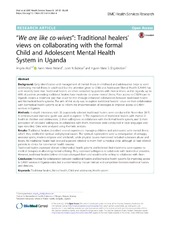| dc.contributor.author | Akol, Angela | en_US |
| dc.contributor.author | Moland, Karen Marie | en_US |
| dc.contributor.author | Babirye, Juliet N. | en_US |
| dc.contributor.author | Engebretsen, Ingunn Marie S. | en_US |
| dc.date.accessioned | 2019-01-10T08:34:33Z | |
| dc.date.available | 2019-01-10T08:34:33Z | |
| dc.date.issued | 2018-04-10 | |
| dc.identifier.issn | 1472-6963 | |
| dc.identifier.uri | https://hdl.handle.net/1956/18870 | |
| dc.description.abstract | Background: Early identification and management of mental illness in childhood and adolescence helps to avert debilitating mental illness in adulthood but the attention given to Child and Adolescent Mental Health (CAMH) has until recently been low. Traditional healers are often consulted by patients with mental illness and in Uganda, up to 60% of patients attending traditional healers have moderate to severe mental illness. Poor access to CAMH care in Uganda creates a treatment gap that could be met through enhanced collaboration between traditional healers and biomedical health systems. The aim of this study was to explore traditional healers’ views on their collaboration with biomedical health systems so as to inform the implementation of strategies to improve access to CAMH services in Uganda. Methods: In-depth interviews with 20 purposively selected traditional healers were conducted in November 2015. A semi-structured interview guide was used to explore: 1) The experiences of traditional healers with mental illhealth in children and adolescents; 2) their willingness to collaborate with the formal health system; and 3) their perception of clinicians’ willingness to collaborate with them. Interviews were conducted in local languages and tape recorded. Data were analysed using thematic analysis. Results: Traditional healers described several experiences managing children and adolescents with mental illness, which they ascribed to spiritual and physical causes. The spiritual explanations were a consequence of unhappy ancestral spirits, modern religions and witchcraft, while physical causes mentioned included substance abuse and fevers. No traditional healer had received a patient referred to them from a medical clinic although all had referred patients to clinics for non-mental health reasons. Traditional healers expressed distrust in biomedical health systems and believed their treatments were superior to medical therapies in alleviating mental suffering. They expressed willingness to collaborate with biomedical providers. However, traditional healers believe clinicians disregard them and would not be willing to collaborate with them. Conclusion: Potential for collaboration between traditional healers and biomedical health systems for improving access to CAMH services in Uganda exists, but is undermined by mutual mistrust and competition between traditional healers and clinicians. | en_US |
| dc.language.iso | eng | eng |
| dc.publisher | BioMed Central | eng |
| dc.relation.ispartof | <a href=" http://hdl.handle.net/1956/18872" target="blank"> Access to Child and Adolescent Mental Health services in Uganda: Investigating the role of Primary Health Care and Traditional Healers</a> | |
| dc.rights | Attribution CC BY | eng |
| dc.rights.uri | http://creativecommons.org/licenses/by/4.0/ | eng |
| dc.subject | Traditional healers | eng |
| dc.subject | Mental health | eng |
| dc.subject | Child and adolescent | eng |
| dc.subject | Health system | eng |
| dc.title | “We are like co-wives”: Traditional healers' views on collaborating with the formal Child and Adolescent Mental Health System in Uganda | en_US |
| dc.type | Peer reviewed | |
| dc.type | Journal article | |
| dc.description.version | publishedVersion | en_US |
| dc.rights.holder | Copyright 2018 The Authors | |
| dc.source.articlenumber | 258 | |
| dc.identifier.doi | https://doi.org/10.1186/s12913-018-3063-4 | |
| dc.identifier.cristin | 1607273 | |
| dc.source.journal | BMC Health Services Research | |
| dc.source.40 | 18 | |

